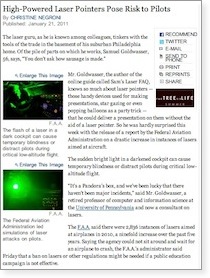Home
A comprehensive resource for safe and responsible laser use
US: Military aircrews can use finger-mounted laser pointers for target identification
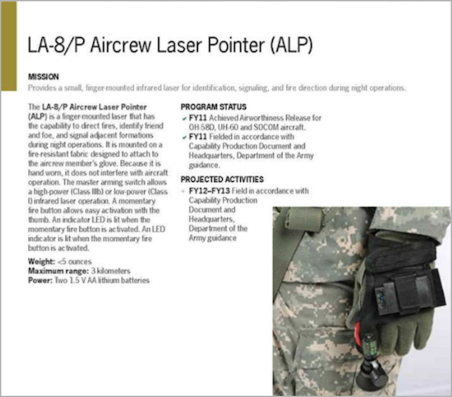
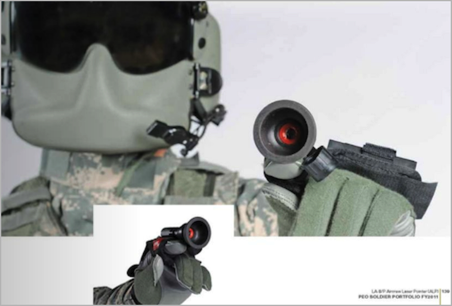
For the military laser enthusiast, the catalog contains a number of other laser devices such as the AN/PEQ-14 Integrated Laser White Light Pointer (actually a white flashlight plus a visible and an invisible laser):
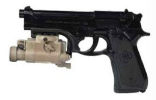
From the Program Executive Officer Soldier Portfolio FY2012 catalog. The LA-8/P is on printed pages 138-139, electronic pages 146-147. Originally found via GovWin.
Commentary from LaserPointerSafety.com: Although the LA-8/P Aircrew Laser Pointer does not emit a visible beam, it would be easy to make a visible version so that aircrews could “fire back” at persons on the ground aiming laser pointers at them. Whether this is a wise idea is another matter.
.
New Zealand: Concern over laser incidents
The tower manager, Fred Hanson, was quoted as saying he would like to make lasers illegal because “it just totally changes the light effect in the airplane.” The president of the New Zealand Air Line Pilots’ Association also called for restrictions such as licensing, and having to have a reason for possession: “They do have the potential to wreak a lot of damage.”
A spokeswoman for Air New Zealand said the airline was concerned, and they support prosecution. New Zealand law calls for up to 12 months in prison or a fine of up to $10,000 for interfering with an aircraft. In a current case, two Auckland men are being prosecuted for aiming a laser at a police helicopter.
From the Waikato Times
Note: LaserPointerSafety.com has run two stories to date about New Zealand laser incidents where the penalty was said to be up to 14 years. They can be found here.
Israel: "Laser dreidel" toy's safety questioned
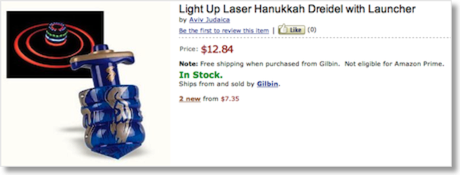
This dreidel projects two laser dots, creating two circles when spun (insert photo). The listing above is from the U.S. Amazon.com website.
The news story points out that laser pointers can cause permanent vision damage. In addition, the story says the laser is sold “without a filter,” probably meaning without an infrared (IR) filter. IR light can damage the retina -- like visible light -- but also could damage the cornea.
.
US: Airborne missile-killing laser project mothballed after $5 billion
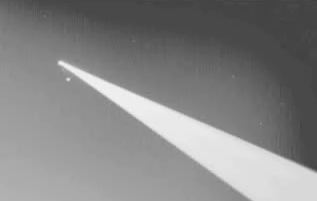
Cockpit view of the ABL shooting down a missile on Feb. 11 2010. Video is here.
A key reason for the ABL shutdown was the cost of the project versus the projected military returns. Another reason is that the Missile Defense Agency is looking to a new generation of laser systems with “much denser capacity or greater power lasers in smaller packages and operating at much higher altitudes.” Unmanned aerial vehicles would be an ideal platform. The MDA’s director said antimissile drones using solid-state lasers could be a reality by 2020.
From Aviation Week. An analysis of laser weapons is at Strategy Page.
Commentary from LaserPointerSafety.com: We included this story because people sometimes wonder if lasers aimed from the ground can damage an aircraft’s airframe. The short answer is “no”. It would take a system similar to the $5 billion ABL. However, the Missile Defense Agency is now indicating that military-developed solid-state lasers may be able to cause enough damage to down a missile -- or aircraft -- within this decade (the 2010s).
While it is unlikely that non-state groups could deploy such a device, it is more of a possibility than independently developing an ABL-like COIL gas laser. For the foreseeable future, the threat to aircraft remains the visual impairment caused by bright laser light, and to a lesser degree, the possibility of causing retinal lesion eye injuries.
.
US: FDA updates "Red List" of banned laser importers and products
- The laser product does not have a permanently attached warning logotype label;
- The laser product output exceeds 5 milliwatts;
- The laser product fails to contain certification or identification information either on the product or in the instructions for use;
- The laser product fails to contain instructions for safe use;
- The product class or output information on the laser product's warning logotype label is different from that in the instructions for use; and/or
- A product report for the laser product has not been submitted.
Products which can be Detained Without Physical Examination (DWPE) include laser pointers, laser gunsights, laser pens, laser light show projectors, laser special effects, laser levels, toy guns with lasers, laser pointer key chains, and similar products.
It is unclear what effect the FDA’s import restrictions have on supplies. For example, the well-known company Wicked Lasers is listed multiple times as being banned from importing “All laser products and all products containing lasers.” However, a company representative on December 22 said that Wicked does ship to the U.S. and there should be “no issues getting a laser into the U.S.”
Violating companies are listed as follows.
- Canada: 2 companies shipping from a total of 3 addresses
- China: 51 companies shipping from a total of 57 addresses
- Hong Kong: 9 companies shipping from a total of 9 addresses
- Japan: 1 company shipping from a total of 2 addresses
- Taiwan: 25 companies shipping from a total of 28 addresses
- United Kingdom: 1 company shipping from 1 address
From the December 20 2011 update to the FDA Red List
US: Report says Iran blinded CIA satellite with laser
This was the only laser-related information in a December 15 2011 article that was otherwise about Iran tricking a U.S. drone into landing in Iran by jamming its GPS position signals.
From the Christian Science Monitor; the laser paragraph was on page 2 of the online story. See also an October 2011 Washington Post story analyzing a politician’s claim that China blinded U.S. satellites in 2006.
.
UK: Police dazzler laser being tested to flashblind rioters
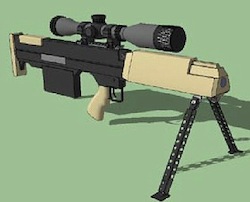
Concept of the rifle, from the Daily Mail
The developer is Photonic Security Systems, which also markets the rifle as a pirate deterrent. The Telegraph says that similar devices have been used in Afghanistan by NATO-led International Security Assistance Force troops.
PSS managing director Paul Kerr told the International Business Times "The very purpose of this technology is to be non-damaging … If someone is prepared to just stand there and stare down the barrel at this, which would be incredibly uncomfortable, then they are definitely a threat.” He said that he has often been exposed to the laser: "The quality and safety of the device is paramount and I know that first hand because I have been the guinea pig many times. I know what it is like and I know how effective it can be."
Author and activist Cory Doctorow points out that “the UK is a signatory on the Protocol on Blinding Laser Weapons … this weapon wouldn’t run afoul of international law if it (merely) reduced your vision to the point where you were impaired but not legally blind, permanently.” Doctorow also says “Twitter wags are already predicting a resurgence of mirrorshades [reflective sunglasses] among protesters.”
From the Telegraph, the Daily Mail, the International Business Times and BoingBoing. See related story on BAE Systems anti-pirate dazzler.
.
Wales: Eight people convicted of laser offences thus far in 2011
A spokesperson noted that several of the arrests involved young people. He said, “We’re hoping parents will see this message so they can remind their children, if they have access to laser pens, not to use them irresponsibly.”
According to the news story, the maximum penalty for recklessly or negligently acting in a manner likely to endanger an aircraft is a fine up to £5,000, and/or five years imprisonment.
From NewsWales. One LaserPointerSafety.com news item about a 2011 Wales conviction is here.
Australia: Kevin Spacey uses laser pointer to shush audience members
From the Sydney Morning Herald
World: Laser pointer focus/aiming aid for cameras
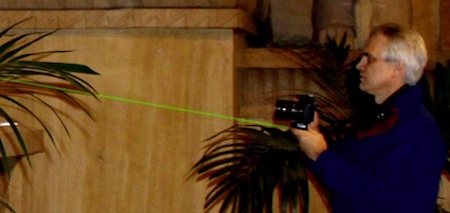
A promotional photo demonstrating the concept of the PinPoint Focus Assist
The manufacturer says the PinPoint complies with U.S. FDA safety regulations. It is said to be a Class 2 green DPSS diode with output power less than 1 milliwatt. The focus range is from 2.5ft/7.5m to 131ft/40m; the aiming range is 700ft/210m in low-light and “further in darkness”.
At their website, DeluxGear has an admirable list of safety warnings which include:
- Don’t aim at a person’s eyes. This can cause “temporary vision dysfunction such as flash blindness, disorientation or glare. This can be particularly dangerous if the exposed person is engaged in a vision-critical activity such as driving or other means of transportation.”
- Don’t aim it at a person without notifying them in advance.
- Don’t aim at a law enforcement officer as this is illegal in many jurisdictions.
- Never aim at vehicles including aircraft.
- Don’t allow a minor to use unsupervised. In some jurisdictions it is illegal for a minor to purchase or use a laser product
Incidentally, the beam on/off function is separate from the camera. This means the beam does NOT come on when the shutter button is pressed, but instead is controlled by a separate switch on the PinPoint.
From DeluxGear; click on the “Protect Your Gear” menu to read the list of safety warnings.
.
US: North Myrtle Beach passes laser pointer restrictions
From the North Myrtle Beach Times and CarolinaLive. For additional background, see other LaserPointerSafety.com stories on problems and ordinances in North Myrtle Beach and its neighboring city Myrtle Beach, plus resort cities Ocean City, and Virginia Beach.
.
.
Halloween special: Are green beams in UK laser pens or UFOs?

Could a UFO with green lights have caused this crack?
It follows a report to the Halstead Gazette and a UFO website that a resident saw green lights rotating above her in Nether Court on Friday and left a large crack in the ground.
The frightened woman's daughter, who would only be identified as Nel, called Essex Police after the 7pm incident to check if it was the force helicopter. A police spokesman said it was not the helicopter but could have been laser pens.
But Nel is adamant it was not laser pens, and has since carried out internet research suggesting similar beams have been seen in diverse places such as Cornwall, Mexico, Nova Scotia and China.
From the Halstead Gazette on October 28 2011. Also, see this post at UK UFO Sightings; scroll down for the comment from Nel.
.
.
UK: BALPA wants lasers classified as weapons and banned EU-wide
From The Independent and the Daily Mail
.
US: ALPA holds major D.C. conference on the threat of laser illuminations
Speakers generally agreed on the nature and scope of lasers as a threat to air safety. They also offered similar solutions, including educating the public to not misuse lasers, prosecuting those who do, training pilots on how to "recognize and recover" from incidents, increasing the number of reports from pilots and the public, and restricting laser pointer availability.
The ALPA conference made news primarily for the announcement of a new FAA web page, which can be reached via www.faa.gov/go/laserinfo. FAA Administrator Randy Babbitt told the ALPA attendees that the web page -- erroneously described as a "website" in many media accounts -- would centralize the agency's information on laser/aviation safety. The page includes email addresses where pilots, air traffic control and the public can report laser incidents (see separate story about the FAA web page).
Babbitt also said that the FAA currently has filed 18 civil cases against individuals who aimed lasers at aircraft. There is a maximum $11,000 fine in each case.
Other speakers gave updates and information in their areas of expertise.Click to read more...
US: FAA urges pilots, public to report incidents on new webpage
- Reporting Laser Incidents: How to report an incident, for pilots, air traffic control officials, and the general public
- U.S. Laser Incidents by Year: A simple table listing incidents each year since 2005
- Laser Events and Civil Penalties: Press releases about the number of incidents in 2010 and about the June 2011 decision to impose civil fines of up to $11,000. Also, the legal interpretation justifying imposition of the fines.
- Hazards of Laser Illumination: Links to background information for pilots, and two studies of the issue by FAA’s Civil Aerospace Medical Institute
- Planning Light Shows and Other Outdoor Laser Operations: Information and forms for persons planning to use lasers outdoors
Below is the FAA press release announcing the web page:Click to read more...
Switzerland: Air rescue pilots to use laser protective eyewear
The action was taken because laser attacks are on the rise: six in 2009, 11 in 2010 and 16 to mid-October in 2011.
The sale of strong laser pointers was banned in Switzerland in May. The Federal Health Office is currently reviewing the possibility of banning their possession and use. Checks carried out by the Federal Office of Metrology this year showed that more than 95 per cent of the pointers tested were stronger than the permitted limit.
From SwissInfo.ch
UK: Heathrow laser incidents almost triple
From BBC News
Russia: Laser attack law passes first step in Parliament
The bill stipulates that hooligans whose actions have threatened transport safety will be fined 80,000 rubles ($2,580) or sentenced to up to three years in prison. People caught with pointing lasers at aircraft will get 7-year jail terms. Hooligans whose actions have led to the death of people or other grave consequences will get up 10 years in jail.
The bill also lowers the age of persons who could be punished for laser hooliganism from 16 to 14 years.
Only five cases of laser attacks were registered in the country in 2010, but in 2011 the number jumped to more than 30. One suspect was caught in Moscow this June, and another in the southern Russian republic of Chechnya a month later and received little or no punishment. A 17-year-old suspect was told he would "face very strict measures" if a similar incident occurs again, the Chechen Interior Ministry said on its website.
From RIA Novosti
Iran distributes centrifuge-shaped laser pointers at atomic energy meeting
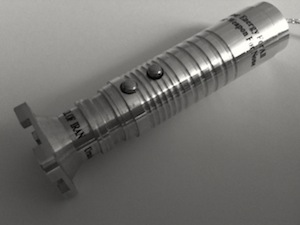
The laser pointer is imprinted with the slogan “Nuclear Energy for All, Nuclear Weapon for None” at the top, and “I.R. of Iran, Uranium” at the bottom. The design is based on the Iranian IR-1 centrifuge, which in turn is based on the Pakistani 1 (P-1).
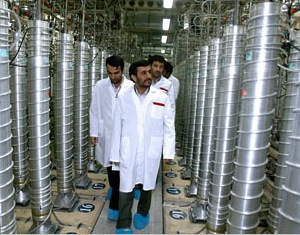
Iranian President Mahmoud Ahmadinejad walks past rows of IR-1 nuclear enrichment centrifuges during a tour of Natanz on April 8 2008.
Iran’s nuclear program has been heavily scrutinized by Western countries, with several United Nations resolutions imposing sanctions on the country. It is widely believed that the U.S. and Israel may have developed and distributed the Stuxnet virus in order to cripple Iranian centrifuges. Approximately 1000 IR-1 centrifuges were damaged, out of about 10,000 total centrifuges at the Natanz uranium enrichment facility.
From Jeffrey Lewis at Arms Control Wonk via The Envoy at Yahoo News, with additional research from the New York Times and Wikipedia
US: New "laser strike protection" website and training from Night Flight Concepts.
The company also introduced the Laser Eye Protection Program training course. It is intended to “teach aircrew members the capabilities, limitations and preventative measures required to respond to a laser strike.” The cost is $125; the course takes about an hour and has a test at the end.
[Note from LaserPointerSafety.com: Pilots may also wish to review our online information from the SAE G10T and other sources on how to recognize and recover from laser illumination incidents.]
Germany: BMW shows safety features of its new laser headlights
Each of the four headlights uses three blue lasers. The lasers are directed by mirrors onto a lens containing yellow phosphorus. This re-emits white light onto a larger mirror that reflects it out the headlight glass onto the road.
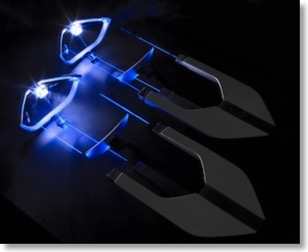
Two of the four laser headlights are shown here. The resulting white light beam is emitted toward the upper left of the photo.
The system is 1000 times brighter than LED headlights, uses half the power, lasts just as long (10,000 hours) and allows more flexible designs. BMW noted that light emitted from the headlights is not laser light, and is safe to stare into. In case of an accident, the headlights are powered down so no laser light could escape.
[Note from LaserPointerSafety.com: It is likely that the laser diodes in the headlight are the same type used in Casio’s Green Slim projectors and the Wicked Laser Spyder III Arctic handheld laser. These are relatively inexpensive -- less than $30 each in quantity -- and produce a nominal 1 watt of light.]
From Motor Trend
US: UPDATED - Myrtle Beach CAP official witholds safety flights after being charged for confiscating laser pointer from 12-year-old (+ 2 updates)
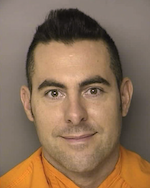
Stephen Teachout
In retaliation, Teachout said the three-pilot Civil Air Patrol would not provide help to Horry County (where Mytle Beach is located) for certain calls including offshore missing persons and forest fires. According to the Sun News, Teachout said “I support Horry County but if they don’t have [the pilots’] backs then no thanks. We don’t need to be here.”
Click to read more...Europe: 4,266 laser incidents; harmonized criminal laws sought
In 2008, there were 1,048 European incidents.
A Eurocontrol safety expert said “Preventing and mitigating the current problem requires a harmonized approach throughout Europe. We need the full involvement of regulators, judicial authorities, police, airlines and their associations, air navigation service providers, laser manufacturers who must understand how serious the problem is, as well as research institutes.”
Most European countries do not have specific laws against aiming lasers at aircraft. Eurocontrol stated they should be subject to the same restrictions as firearms, covering the purchase, transportation and use of lasers.
German politician Volker Kauder said that high-powered lasers should be treated as weapons under the Geman Arms Act.
From the Washington Post
US: Va. Beach wants state of Va. to ban aiming lasers at airplanes
The City Council is considering a local law to make malicious shining of lasers a Class 1 misdemeanor (up to a year in jail and a $2500 fine). According to PilotOnline.com, in 1998 Virginia Beach “was one of the first in the nation to make it a crime to shine lasers at police officers or into people’s eyes.”
The city is also planing an educational campaign to inform people about the law and laser dangers.
Commenter “Lost_Sailor” said there already is a Virginia state code, 5.1-22, “Interference with operation of aircraft,” to address the problem. He linked to a 2002 Virginia Court of Appeals case upholding the conviction of a man for using a “million candlelight spotlight” to illuminate a police helicopter. The man unsuccessfully argued that he had no intent to interfere with the helicopter; he wanted to view its registration number for a noise complaint. The man also unsuccessfully argued that his spotlight did not interfere with the operation of the aircraft.
From PilotOnline.com. The comment by Lost_Sailor was submitted on Thursday, 10/06/2011 at 6:40 pm.
US: Politician says China blinded U.S. satellites with lasers
US: Two FBI videos warning against lasers get 250,000+ YouTube views
The video highlights Justin Stouder, a St. Louis-area resident who was arrested in April 2010 for aiming at a police helicopter. He apologized at a news conference in July 2011 intended to publicize the illegality and hazards of lasers aimed at aircraft.
The FBI also released video excerpts of the Stouder laser incident and his subsequent identification by the helicopter and arrest. The incident/arrest video was about 10 times as popular on YouTube, with over 225,000 views:
The press release, and a transcript of the video, are below (click on the Read More… link).Click to read more...
US: Senate bill S. 1608 introduced to help move laser pointer legislation
A news report on WPRI said Whitehouse introduced this as a standalone measure. In February 2011 Whitehouse had proposed the same provisions as Amendment 8 to S. 223, the FAA Air Transportation Modernization and Safety Improvement Act which passed the Senate February 17 2011. Because House action on FAA funding was held up, Whitehouse decided to re-introduce the measure as its own bill.
The House version is H.R. 386 introduced January 20 2011 by Rep. Daniel Lungren, Republican of California. The House bill also provides a penalty of a fine and/or up to five years in prison. It was passed by the full House on February 28 2011.
It is likely that S. 1608 will successfully pass in the Senate Judiciary Committee and the full Senate. If the bill is identical to H.R. 386, then the legislation would be sent to the President for his approval and signature. If the bill differs from H.R. 386 -- for example, if amendments are added -- then a House/Senate reconciliation committee would meet to work out the differences, in advance of sending a single piece of legislation to the President.
From WPRI.com. S. 1608 can be tracked on GovTrack.us; as of September 25 2011, the text of the bill has not yet been posted.
US: 3 sheriff's officers charged with illegal laser sales
92 laser sights and 74 automatic machine guns were ordered between Sept. 2008 and January 2010 on Lake County letterhead and purchase orders. The officers paid for the products with personal funds. The amount earned from Internet resales was not stated, although the three officers were also indicted for understating their personal income by a total of $387,000.
The laser products came from Insight Technology Inc. and Laser Devices Inc. The 92 restricted laser sights were purchased for approximately $1000 to $1400 each and were sold on eBay for around $2800 to $4200 each. A special agent of the U.S. Food and Drug Administration (which regulates laser devices) made an undercover purchase as part of the evidence-gathering process in the case.Click to read more...
US: Laser safety training part of UAW/GM labor pact
Due to the potential for catastrophic injuries from lasers, the UAW bargaining team pushed hard to expedite safety training in this growing field. Within 30 days of ratification, the UAW-GM Health and Safety Training Department will schedule a train-the-trainer (T3) Laser Safety Awareness Training course to be taught at the CHR [UAW-GM Center for Human Resources].
From the UAW GM Report via DetroitNews.com
US: North Myrtle Beach considers laser pointer ordinance (UPDATED - Ordinance passed)
The city has received more than 100 complaints about laser misuse. A spokesperson for the city said “We've had many complaints this past summer about people, mostly people under 18, shining the green laser into the condominiums, into hotel rooms … at people on the beach, at animals, and even at turtles. When they were hatching, they would shine them on the small turtles and lead them away from the ocean.”
(Note: the city of North Myrtle Beach is separate from its neighbor Myrtle Beach which has enacted restrictions on pointers.)
From CarolinaLive-WPDE and WMBFnews.com
UPDATE November 28 2011: The ordinance passed its second reading and now will officially go on the books in North Myrtle Beach. From North Myrtle Beach Times and CarolinaLive.
US: Reporter discusses how U.S. Constitution covers laser pointers
Writing on Constitution Day, September 17, David Fahrenthold frames the issue to illustrate a new House of Representatives rule requiring every bill to reference it’s Constitutional authority.Click to read more...
US: Orlando Sentinel runs article on laser hazards
From the Orlando Sentinel
Switzerland: Laser pointer labels can understate their power
The Swiss government banned the sale of “powerful laser pointers” in May 2011. According to World Radio Switzerland, the country is considering a ban on owning such pointers.
From World Radio Switzerland
US: UPDATED - Myrtle Beach proposes severely restricting lasers
For adults, the proposal would ban use in public such as beaches, parks or streets. It would be illegal to aim lasers at a person, animal or vehicle. Violation would be a misdemeanor, with a penalty of up to a $500 fine and one month in jail.Click to read more...
Worldwide: New 1 watt green handheld laser can distract pilots 20 miles away
LaserPointerSafety.com’s analysis shows it is a distraction hazard to pilots up to 20 miles from the laser source.Click to read more...
US: St. Louis area sheriff's department to use anti-laser glasses
The eyewear, made by NoiR, significantly reduces laser light, without adversely affecting pilot vision of cockpit instruments or airport lights. Because some laser light is transmitted, pilots and flight officers will still be able to track the source of a laser illumination.
The decision to purchase the glasses was made because of recent laser incidents in the St. Louis area. A spokesperson said the eyewear is “another tool to keep us in the air.”
From STLtoday.com
Russia: "Dragging its feet" on laser incidents
US: Laser beams usually are not tracking aircraft; most do not enter cockpit windows
The analysis was done by Rockwell Laser Industries (RLI). They examined 6,903 incidents in FAA’s database, dating from 2004 to mid-March 2011.The cockpit was illuminated only in about 1,875 incidents (27%). Of these, the exposure appeared intentional in about 350 incidents (19% of the cockpit illuminations; 5% of all illuminations). “Intentional” was defined as multiple beam exposures or the beam tracking the aircraft.
There were about 100 incidents (1.5% of all incidents) reported eye effects or injuries to the eyes. (A separate analysis by LaserPointerSafety.com shows that the vast majority of eye effect/injury reports are of minor, temporary effects. There are a few claims of eye injuries, and a very few confirmed claims of retinal injury.)
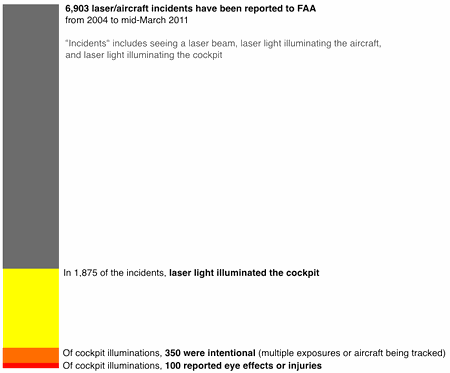
The RLI analysis was done by Kevin Donnelly, and was supervised and presented in August 2011 by RLI president Bill Ertle. Rockwell Laser Industries is a pioneer in providing services and products related to lasers and laser safety.
US: Military helicopters may use lasers to fight ground-based attacks
Black Hawk and Chinook helicopters have been testing a acoustic detection system called “Helicopter Alert and Threat Termination”, or HALTT. This uses microphones to detect the sound of a bullet or RPG. Delays in the sound reaching the microphones enables them to determine the sound’s location. A similar truck-mounted system is already in use. It can automatically swivel and fire a gun in the direction of the sound.
For helicopters, HALTT can be combined with guns and/or lasers. Infrared lasers help confuse missile guidance systems, while visible lasers would dazzle and flashblind anyone aiming at the helicopter. An engineer said the principle is to “make it impossible for a human to observe your aircraft … by creating a distracting light source. That has been done in the past and is a proven technology…”. The HALTT/laser countermeasure system could be in use by 2017.
The military already uses laser dazzlers at checkpoints, to warn approaching vehicles and to cause glare on anyone taking aim at soldiers.
From Wired and Defense Tech. A video of how the IR system would work against a missile is at YouTube.
Uzbekistan: Meeting held to discuss laser "attacks"
Among those attending the meeting were representatives from the Ministry of Internal Affairs, committees of the city, flight crews and air traffic controllers.
[Note: News reports did not indicate whether laser incidents had yet taken place in Uzbekistan. A Google News search for anything to do with lasers in Uzbekistan turned up no results.]
From Trend and Central Asia Online
Philippines: Bill introduced to penalize laser assaults
Senate Bill 2888 was introduced by Antonio "Sonny" Trillanes IV, as a result of laser illuminations on aircraft at Manila International Airport.
The Manila Bulletin reports the bill's provisions as follows:
- “Any person who uses a laser pointer, pen or similar device to distract, annoy or attack another person” faces prison terms of from three to six months, or a fine ranging from P10,000 to P100,000.
- When the attack results to damage or destruction of property, the penalty shall be three times the value of the damaged property and imprisonment of six months to one year.
- When the person attacked suffers from temporary or permanent disability or injury of any kind, the penalty shall be imprisonment from one year to three years.
- When the person attacked is operating a motor vehicle, the penalty shall be four years to eight years.
- When the person is operating an airplane or helicopter or a ship at sea, the penalty will be imprisonment ranging from eight to ten years.
Canada: Calgary astronomers agree with $5000 fine
Saulnier told police he had the pointer because he was an amateur astronomer. The Calgary representatives of the RASC said Saulnier was “not an RASC member, nor [was he] known to us.” They pointed out that responsible amateur astronomers would use lasers only on astronomical targets on clear nights when others are present: “There is no legitimate solo use of pointing a laser pointer into the sky that we can think of.”
From the Calgary Herald
US: LIA warns against dangers of laser pointers
LIA did not give specific recommendations to avoid eye injuries, other than individuals being cautious. They did note that “[t]here is an active debate about what should be done. Is the solution education, regulation or prohibition for this type of hand-held laser device?…. Until the time that these lasers are statutorily banned, regulated through licensing or are widely recognized as a hazard, many more injuries will occur. The public should take note of these dangers immediately and keep these high-power, hand-held devices away from children and the untrained user.”
Full text of the July 26 2011 press release from LIA News is below (click the “Read More…” link).Click to read more...
Canada: Health Canada warns about dangers of pointers, handhelds
They caution that laser pointers should be limited to IEC Class 3R (less than 5 milliwatts for visible beams). Health Canada says that higher powered Class 3B and 4 lasers “should not be used as laser pointers or in any other application unless operated by individuals who have been professionally trained in laser safety.”
The full text of the press release, including instructions on how to report suspected laser injuries, is available by clicking the “read more” link below.
From MarketwireClick to read more...
New Zealand: Laser restrictions to be proposed in Parliament
From Scoop Independent News
US: New Illinois law bans aiming lasers at aircraft
From the Chicago Tribune
See LaserPointerSafety.com’s prior coverage of the bill here.
Germany: "Iron Man" laser fires Class 4 beam from a hobbyist's palm
Hobbyist Patrick Priebe’s inspiration was the comic book character “Iron Man”, who has “repulsor rays” in the palms of his armor’s gloves. Priebe’s device is self-contained, with the battery in a case that wraps around the back of the hand. Simply flexing his hand triggers the beam to fire.
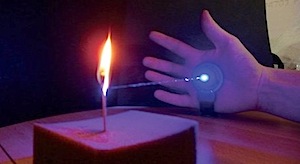
Priebe’s 1 watt, 445 nm blue laser beam ignites a match
His inspiration: Iron Man’s repulsor ray glove, as seen here in the motion picture with Robert Downey, Jr.
Priebe made a number of versions. He is selling limited numbers (not mass-produced) of kits and assembled gloves on laser pointer forums for $200-500 depending on the version.
From Popular Science and many other sources. Details on the construction are at Hacked Gadgets. Videos of the device in action are here and here.
US: Second Ocean City NJ vote against pointers makes laser ban official
Russia: Jail proposed for laser "hooligans"; media asked to not report incidents
The Moscow Times said Rostov-on-Don’s police chief wanted a 10-year term for people who blind pilots if their actions result in deaths. Alexi Lapin also blamed media attention for encouraging copycats: “Publicity in the media only encourages them to act. In medicine, this is called an epidemic, and it has yet to peak.”
Others agreed with the police chief’s media theory, including the leader of Chechnya, Ramzan Kadyrov, who banned laser pointer sales (and by some media accounts, possession) on July 4 2011. A senior Transportation Ministry official asked media to stop covering the incidents: "Judging by the European experience, the less information there is on the issue, the fewer cases"
The attention comes after more than 50 reports of “laser hooliganism” thus far this year in Russia. This compares with five incidents in all of 2010.
From RIA Novosti., the Moscow Times and Bloomberg. See also other LaserPointerSafety.com stories about Russian aviation incidents and laser statistics.
Russia: Chechnya bans laser pointer sales after one incident
Worldwide: Laser pointers reach 2000 milliwatts (2 watts)
To give an idea of its power, here are some comparisons:
- The U.S. limit for a laser to be sold as a pointer is 5 mW (0.005 watt). The new lasers are 400 times more powerful than a “legal” laser pointer.
- The infamous Wicked Laser Spyder III Arctic is nominally a 1000 mW laser (1 watt). However, most Arctics actually emit around 800 mW, so if the new lasers really reach 2000 mW then they are 2.5 times as powerful as a Wicked Arctic.
- The most dangerous laser classification, Class 4, begins at 500 mW (1/2 watt) for visible light. Class 4 lasers can cause instant eye damage, skin burns, and can be a fire hazard for certain materials. The new devices are four times the minimum for a Class 4 laser.
- A 2000 mW laser is an eye hazard up to about 1,000 feet away from the laser.
US: Ocean City NJ initially votes to ban sales, possession of laser pointers
The move comes after significant laser misuse during the resort city’s 2010 summer season, and a rise in 2011 incidents against aircraft, vehicles and citizens. The “straw that broke the camel’s back” may have been a June 7 illumination, where a 21-year-old purchased a green laser pointer from a Boardwalk store and almost immediately aimed it at a Coast Guard helicopter two miles offshore. The man, Eric Bouda, was arrested within minutes. (More on the story here.)
Last year, the local merchants’ association and the police asked for a voluntary ban on sales. However, the ban was not successful, with merchants resuming sales for competitive reasons.Click to read more...
UK: 270% rise in Surrey-area laser pen incidents
A spokesperson pledged to “deal robustly with any incident involving laser light whether it is an assault on another member of the public or a device being pointed at a vehicle. Laser pen owners should also be aware that Surrey Police’s collision investigation unit can pursue a manslaughter charge if it is found that a fatal or life changing injury collision is due to the use of a laser light. All offences have a power of arrest and could result in a term of imprisonment.”
Police are especially concerned about aircraft illuminations in East Surrey, near Gatwick Airport.
From Elmbridge Today, BBC News, and Redhill and Reigate Life. A list of laser pen offences, compiled by the Surrey police, is here.
Russia: UPDATED - Laser "blindings" increase
On June 8, a pilot was blinded by a laser pointer while landing a Boeing passenger plane in the southern city of Rostov-on-Don, but managed to land safely. The beam came from the area of a local market.
Earlier in the week a pilot of an Airbus A320 plane was blinded by a laser light during landing at the same airport
From RIA Novosti. In addition, Pravda carried a story with some additional details. See also other LaserPointerSafety.com stories about Russian aviation incidents and laser statistics.
UPDATED - June 24 2011: The German news agency DPA reported that these attacks, and additional ones in June in Rostov-on-Don, are the result of Islamist insurgents in the Caucasus region. See this story for details and sources.
UPDATE 2 - July 5 2011: A spokesman for the Federal Air Transport Agency said there have been more than 50 cases of “laser hooliganism” thus far this year in Russia, according to Bloomberg.
Canada: Pilots want lasing to be a criminal offense
Currently, violations of the Aeronautics Act can lead to fines of up to $100,000 and up to five years in prison. Despite this, laser illuminations continue to occur.
In 2010, there were 182 reported laser pointing incidents. Ontario had the highest number, 69, followed by Quebec with 53 incidents. Transport Canada and the ACPA said this was due to increased reporting, copycat laser use, and the increased availability of laser pens and pointers.
“This is just like shooting a gun at an airplane around [an] airport,” according to Nick Stoss, formerly with the Transportation Safety Board.
From Global Winnipeg
US: FAA to impose civil penalties of up to $11,000
The Wall Street Journal states that “[t]he change is intended to make it easier to punish violators without resorting to time-consuming criminal proceedings.”
Previously, FAA did not go after laser violators directly. FAA will now routinely bring civil charges, and these will be in addition to any other civil or criminal charges brought by others such as the FBI, or state and local law enforcement.Click to read more...
South Africa: Incidents are increasing; pilots express concern
A representative of the Civil Aviation Authority said that laser misuse violates two sections of the Civil Aviation Regulations, and can be punished with a fine and/or imprisonment of up to 10 years. (There was an arrest in 2010 during the World Cup, when 35-year-old Yusuf Ebrahim temporarily blinded a helicopter pilot.) The CAA representative said the Authority would consider new standards or regulations if they were recommended by the International Civil Aviation Organization.
To report a laser illumination incident in South Africa, CAA said to email information to cahrs@caa.co.za or fax it to 011 545 1453.
From Independent OnLine Scitech. An IOL story about Yusuf Ebrahim’s first court appearance is here.Click to read more...
South Africa: Up to 12 incidents per week, say pilots
ALPA-SA is calling for public education and a ban on handheld laser sales. According to the organization, there was a temporary drop in the number of incidents after media reports earlier in 2011, but the incidents are now on the rise again.
A spokesperson for the Civil Aviation Authority said “a few cases” had been reported thus far in 2011. He added that if the International Civil Aviation Organization introduced new regulations, the CAA would “definitely look into implementing it.”
From the Cape Argus
US: UPDATED - Gun-shaped laser pointer for sale
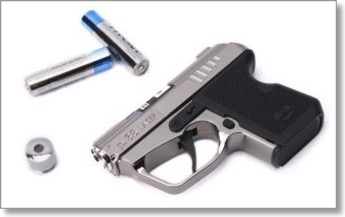
The seller says this is “a good tool for pointing to the faraway target or stars and sending out the SOS signal, making your travelling [sic] funny and interesting.” Fortunately, they also note that “Laser is harmful to people, following uses are forbidden: A. Point the laser at people's faces, especially eyes; B. Point at mirrors or highly reflective surface; C. For children play; D. Observe the laser lines with a telescope; E. Disassemble, test or repair laser pens.”
Thanks to Phyllis Monahan of Lighting Systems Design Inc. (LSDI) for bringing this to our attention.
UPDATED - June 7 2011: Gun-shaped laser pointers have been noted in two police reports we have recently seen. One is a confiscation in Virginia Beach after a teen aimed a gun/pointer at a mounted policeman and his horse. The other is a May 7 incident reported by the Buffalo Grove (Illinois) Patch where police briefly detained youths who had been pointing a gun-shaped laser pointer at vehicles in a parking lot. “The officer contacted the parents who came to pick up their sons. The officer made it very clear to the parents and the youths how dangerous a situation the boys placed themselves into.”
UPDATE 2 - September 16 2014: A 13-year-old Indiana boy was suspended for a week from school, for waving a laser pointer around in a school parking lot. Police said the laser pointer “could look like a gun.” It is unknown if the pointer actually was gun-shaped like in the above photo, or if it was a different shape, such as the cylinder of a barrel, that could be mistaken for a gun.
Onion satire: Pilot about to crash
The article begins: “From the flight deck, this is your captain ....in case you're wondering why the plane feels like it's completely out of control, well, there's currently some [idiot] standing on the roof of his car down near the tarmac shining a laser pointer directly into in my eyes. I literally can't see a goddamn thing.”
The “captain” goes on to explain that “ there were almost 3,000 lasering incidents last year alone.... [t]hat's eight instances per day in which a human being—someone with a conscience who ostensibly knows the difference between right and wrong—drives to an airport, gets out of his car, and entertains himself by shining a [very bright] laser pointer directly into a pilot's eyes.”Click to read more...
New Zealand: Pilots call for restrictions after 16 incidents to date in 2011
According to NZALPA’s vice president Glen Kenny, “There is no restriction on the sale and distribution of commercial-strength lasers in New Zealand. In Australia they treat Class 3 lasers or higher as a potential weapon."
NZALPA had previously proposed restrictions in New Zealand “two or three years ago” but the organization wanted it given a higher priority. A spokesman for the Ministry of Health’s National Radiation Laboratory said the issue was “still being considered.” He did note that there have been “successful police prosecutions where people had carelessly or deliberately aimed lasers at vehicles or aircraft.”
From the New Zealand Herald
Grenada: Increasing incidents
Violators could be charged with interfering with air crew duties. The Authority is looking for the laser perpetrator(s), and has posted notices in newspapers stating that shining lights at aircraft is “a security offense”. Also, several pilots have filed complaints with the Eastern Caribbean Civil Aviation Authority.
From the Virgin Islands News Online
Switzerland: Incidents double to 80 in 2010
From GenevaLunch.com
Norway: Registration now required for laser pointer possession and use
Under the new regulations, a laser pointer is defined as “a handheld laser, battery-operated or otherwise self-powered, designed to be held in the hand and pointing at something in the distance.”
NRPA’s restrictions on use do not appear to apply to use inside a private home. However, permission is required if the laser is to be aimed out the window of a home.
Links (in Norwegian; use Google Translate or similar as necessary)
General notice from NRPA
Laser pointer regulations and application (PDF document)
Thanks to Arild Instebø for bringing this to our attention
Highlights of the Norwegian regulations, and the application for laser possession, are below (click on the “Read More...” link).Click to read more...
Germany: Homemade laser pulse gun packs 1-megawatt punch
This differs from most pointers and handheld lasers, which use lasers that emit continuous light. This one emits a single, strong pulse each time the trigger is pulled. It is “enough to punch holes in plastic sheets, scorch wood, and pop balloons from several feet away” according to Dvice.com.
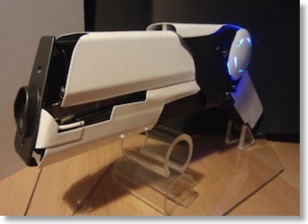
The maker, Patrick Priebe, posted a YouTube video showing the gun in action. He also was offering it for sale. According to Priebe, the gun uses a Q-switched Nd:YAG laser. It takes four seconds to charge the capacitor; the gun then fires a 100 nanosecond, 1 megawatt burst of infrared 1064 nanometer light. The gun took Priebe about 70 hours to build. His YouTube page offers to help others wanting to build their own laser gun.
SAFETY NOTE: Because the laser emits an invisible pulse, it would not be a visual interference hazard to aircraft (e.g., it could not cause glare or flashblindness). At close range the Q-switched pulse would definitely be an eye hazard, causing an explosive steam “pop” on the retina rather than the relatively slow burn of a continuous-wave laser. LaserPointerSafety.com has not done an analysis to determine the “safe” distance, beyond which it would not pose an eye hazard to pilots or others.
From Dvice.com and Hacked Gadgets forum
Italy: 479 incidents in 2010
From L’Eco di Bergamo (in Italian)
US: NY Times says injury increase feared from higher powered lasers
The article listed four injuries to youths. In three of the incidents, a young person deliberately stared into a laser beam, while the fourth was caused by a high-schooler whose friend waved a 50 mW laser in his face. (Besides these anecdotal accounts, the article gave no overall statistics on injuries except to say that an ophthalmologist association is “unaware of any increase in eye injuries caused by lasers.”)
Author Christine Negroni covered a number of topics, including:
- There has been “ninefold increase over five years” in laser illuminations of aircraft
- Eye doctors are “shocked” that high-powered lasers are available on the Internet with no purchase restrictions.
- A U.K. physician says the U.S. limit should be 1 mW, that even at 5 mW laser pointers have “acute” dangers.
- FDA says that noncompliant (“illegal”) lasers are available despite agency seizures.
- Wicked Lasers says that its products are compliant, that they are “extremely clear” about eye and fire hazards on their webpages, and that they will be offering online safety lessons “before checkout”.
- A “large community” of laser enthusiasts wants to keep lasers available.
- An 18-year-old laser hobbyist, who wears goggles and is supervised by his parents, said he was learning about electronics, soldering, physics, light, optics and mechanics.
From the New York Times, online on Feb. 28 2011, in print on March 1 2011 on page D5 of the National edition.
US: House and Senate pass legislation against laser pointer aiming
The bill makes it a crime to aim or illuminate an aircraft with a laser pointer. From the bill:
Whoever knowingly aims the beam of a laser pointer at an aircraft in the special aircraft jurisdiction of the United States, or at the flight path of such an aircraft, shall be fined under this title or imprisoned not more than 5 years, or both. As used in this section, the term ‘laser pointer’ means any device designed or used to amplify electromagnetic radiation by stimulated emission that emits a beam designed to be used by the operator as a pointer or highlighter to indicate, mark, or identify a specific position, place, item, or object.
There are three exemptions in H.R. 386: 1) R&D and flight testing approved by FAA, 2) Defense or Homeland Security department operations, and 3) use of a “laser emergency signaling device to send an emergency distress signal.”
From an AP story running in many locations including here.
COMMENTARY: LaserPointerSafety.com has a page with our analysis of H.R. 386, written before the bill was introduced into the current session of Congress.
Germany: 273 (or 388) incidents in 2010; call for ban on pointers
He recommended fast action. He discussed a European import ban, as well as classifying lasers as a weapon, and prohibiting private possession of Class 3 and Class 4 lasers. He said, “I call on the competent authorities to submit to the problem of dangerous laser fast red tape as possible solutions, before something happens and people get hurt.”
The pilot’s union Vereinigung Cockpit said an import ban is not sufficient, because customs checks are difficult. Cockpit board member Joerg Handwerg said "Although lasers may not be sold in shops with a capacity of more than one milliwatt in Germany, but you get the devices in the Internet.” The group wants to prohibit the possession of equipment for private individuals.
Original articles (in German) from Rettung Magazine, Fluege.de News, and Heute.de.
*NOTE: An April 23 2011 article from N-TV.de says there were 388 “attacks with laser pointers at pilots” in 2010. This is according to the German air traffic control agency, DFS. The article had no additional information that might account for the discrepancy with the 273 incidents in 2010 that is quoted above.
Canada: Man gets lower fine, in part because pilot did not lose control
Provincial Judge Paul Sully said the August 19 2009 incident was "not as serious” as the prosecutor described, since the pilot did not lose control, but instead was "momentarily blinded from viewing his instruments [and] was able to complete his orbits.” In addition, the judge noted that the pilot was familiar with the dangers of laser light.
Judge Sully also rejected the prosecution’s notion that the man should have culpability: “The offender had a momentary loss of common sense which resulted from his failure to recognize the high standard of care needed when handling a laser.”Click to read more...
US: Pentagon delayed using laser dazzers in Iraq
During the U.S. phase of the Iraq war, Marine Corps leaders requested the handheld devices as a way to warn and stop drivers who were overrunning military checkpoints. Wired’s David Axe estimates that “as many as 50” Iraqi civilians were killed by gunfire -- instead of being forced off the road by dazzlers -- during the nine month delay.
There is some dispute over the safety of laser dazzlers. According to the Inspector General’s report,
Laser dazzlers provide a nonlethal capability by emitting an intense light capable of temporarily obscuring the vision of approaching individuals; however, using lasers poses a risk of serious eye injury and permanent blindness. This mode of employing a laser, shining a laser directly into the face or eyes, increases the inherent dangers of using the laser. Using nonlethal laser dazzlers would give Marine operating forces an additional capability to increase stand-off distances, safeguard civilians who venture too close to Marine positions, and help prevent unwarranted escalation of force incidences; however, DoD [Department of Defense] policy prohibits the use of lasers designed to cause permanent blindness. Operating procedures and laser safety measures are essential to ensure the safe and proper use of the lasers.
The Inspector General’s report contains additional details about the range, capabilities, safety concerns and policy issues related to military use of laser dazzlers. For example, the 1995 Protocol on Blinding Laser Weapons states that the signatories (which include the U.S.) “shall take all feasible precautions to avoid the incidence of permanent blindness to unenhanced vision.”
From Wired.com.
Australia: 2008 "cluster attack" caused by boys on bicycles
However, it turns out that this incident was caused by boys on bicycles, apparently acting without pre-planning and not knowing how the lasers would affect pilot vision. During a Feb. 2011 briefing to the SAE G10T laser safety group , FAA flight standards liaison Patrick Hempen said that the truth about Sydney has not caught up with the news stories: “The attacks are usually spontaneous in nature, perpetrated by careless or malicious persons.”
Hempen said that investigation by US and Australian officials revealed that the Sydney "cluster attack" was caused by youths, riding their bicycles on a golf course at night, who stopped and took the occasion to illuminate landing aircraft. He noted that the youths’ local community had a history of acrimony directed at the airport authority due to the construction of a new runway which caused more flights over their residential area.
Hempen also investigated several laser events in the Mideast and found many of the so-called "deliberate attacks" to be similar; they were “events perpetrated by youths, in a party-like atmosphere, without care or knowledge of the havoc that they were causing.”
Based on a Feb. 1, 2011 presentation to SAE G10T.
US: UPDATED -Law proposed in Illinois to criminalize laser pointing
HB0167 is similar to HR 386, a bill currently in the U.S. House of Representatives. One difference is that the state bill criminalizes using any “laser” that illuminates a cockpit, while the federal bill only applies to “laser pointers”. Another difference is that HB0167 contains two of the three exceptions in HR 386. While it provides an exemption for R&D and flight tests, and for the Defense and Homeland Security Departments, the Illinois bill does not provide any exemption for lasers used to signal in emergency rescue situations.
The full text of the bill, along with the status and other information, is available from the Illinois General Assembly.
From the Chicago Tribune (Jan. 26 2011) and St. Louis Post-Dispatch (Feb. 17 2011).
UPDATED - June 15 2011: The bill was passed February 24 by the Illinois House and May 17 by the Senate, and has been sent to the Governor for his signature. From the Illinois General Assembly status page on HB0167.
UPDATE 2 - July 21 2011: The Governor signed the bill. It becomes Public Law 097-0153 and will take effect January 1 2012. From the Chicago Tribune.
US: New York Times calls attention to pilots' laser risk
From the New York Times. Readers of the Times article may also be interested in clarifications, tips and links compiled by LaserPointerSafety.com.
US: 2,836 laser events reported in 2010; FAA expresses concern
FAA spokesperson Laura Brown told LaserPointerSafety.com that in roughly 90% of the reports, the cockpit and/or pilot was illuminated by the laser. (In the other 10%, a beam was seen outside the aircraft but light did not enter the cockpit.) As far as injury reports, Brown said that these were “fairly rare”.
The FAA’s press release listed the top 20 affected airports, with Los Angeles International Airport topping the chart with 102 “laser events” in 2010. LaserPointerSafety.com has further analyzed the airport data to show that for these top 20 airports, an event occurred once every 7,000 takeoffs and and landings; the analysis is here.
According to the press release, “[t]he increase in reports is likely due to a number of factors, including the availability of inexpensive laser devices on the Internet; higher power levels that enable lasers to hit aircraft at higher altitudes; increased pilot reporting of laser strikes; and the introduction of green lasers, which are more easily seen than red lasers.”
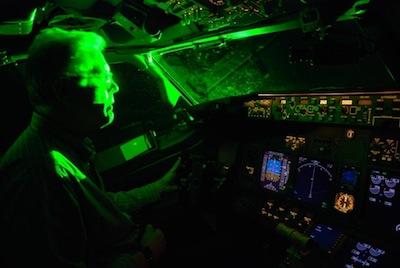
The FAA released the photo above, illustrating what a direct laser illumination of a cockpit can look like.
To read the full FAA press release, and see the list of 20 most affected airports, click the “Read More...” text below. In addition, updated statistics for the current year are here.
UK: Laser "dazzler" from BAE Systems for use against pirates and other threats
Roy Clarke, BAE Systems capability technology lead for laser photonic systems, said: “The effect is similar to when a fighter pilot attacks from the direction of the sun. The glare from the laser is intense enough to make it impossible to aim weapons like AK47s or RPGs, but doesn’t have a permanent effect.”
From the BAE Systems press release.
